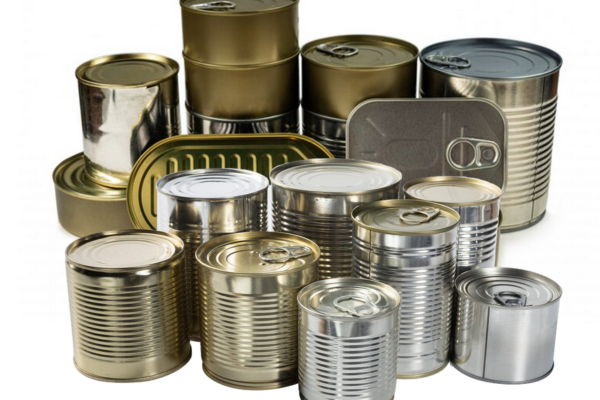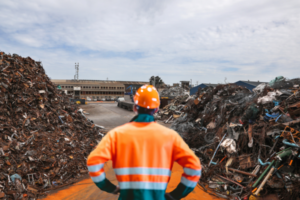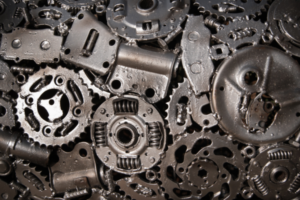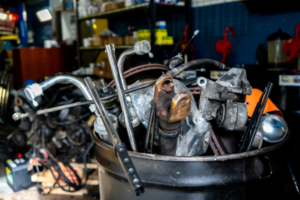Introduction
Recycling is the key to turning waste into valuable resources, especially when it comes to metals. With the world drowning in waste and facing resource depletion, recycling offers a sustainable solution. By reprocessing scrap metal, we can create numerous products that contribute to conserving resources, saving energy, and reducing environmental impact. The demand for metal products is increasing across various industries, putting pressure on natural resources. However, many are unaware of the significant role products made from recycled metals play in promoting sustainability and combating waste accumulation.
Metal recycling not only helps conserve raw materials but also reduces greenhouse gas emissions. From construction materials to everyday consumer goods, a wide range of products are made from recycled metals. Understanding the importance of these products and their recycling processes is essential for promoting a circular economy and sustainable practices.
Table of Contents
The Products Made From Recycled Metals
Let’s explore the top 15 products made from recycled metals to showcase their significance in achieving a more environmentally friendly future.
1. Recycled Aluminum Cans
Recycled aluminum cans stand out as a leading example of successful recycling efforts worldwide. Their efficiency in the recycling process is notable, requiring only 5% of the energy necessary to produce new aluminum from raw materials, making them a sustainable choice. This energy-saving attribute has positioned aluminum cans as a prominent player in the realm of recycled metals.
Aluminum’s long-lasting quality ensures that around 75% of all aluminum ever manufactured is still being utilized today, thanks to dedicated recycling initiatives. This impressive statistic highlights the significant impact that recycled aluminum can have on reducing environmental footprint. Utilizing products made from recycled metals like aluminum enables us to make sustainable choices while benefiting from high-quality goods.
2. Stainless Steel Utensils
Stainless steel utensils, including forks, spoons, and knives, are common products made from recycled metals. This eco-friendly approach not only reduces the demand for new raw materials but also helps in decreasing waste accumulation. The inherent durability and rust-resistant properties of stainless steel make it a top choice for kitchenware as it ensures longevity and easy maintenance.
For example, a set of stainless steel cutlery can be crafted using recycled metal scraps from industrial processes, giving these items a new life while reducing the environmental impact of traditional manufacturing methods. By opting for stainless steel utensils made from recycled materials, consumers actively support sustainability efforts and help conserve energy resources.
Ultimately, choosing stainless steel utensils made from recycled metals is a small yet impactful way to contribute to a greener future.
3. Bicycles
Modern bicycles are leading the way in sustainability by incorporating recycled metal in their frames and components. By recycling metal for bicycle production, manufacturers can significantly reduce waste and lower the carbon footprint associated with manufacturing new metal frames. For example, aluminum bike frames are often made from recycled materials, reducing the need to extract new aluminum from mines and lowering energy consumption in the production process.
Similarly, steel bike frames can also be made from recycled metal, contributing to a more environmentally friendly manufacturing process. In addition to being sustainable, bicycles made from recycled metals are durable and high-quality, offering consumers a long-lasting and eco-friendly transportation option. Consequently, choosing a bicycle with components made from recycled metal not only benefits the environment but also supports the circular economy by promoting resource conservation and reduced landfill waste.
4. Construction Materials
The construction industry plays a significant role in sustainability by utilizing recycled metals. Products like steel beams and reinforcement bars are commonly made from recycled metal, reducing the demand for new resources. By implementing this approach, not only are resources preserved, but also the strength and stability of buildings are improved. For example, using recycled steel in beams can increase their strength and durability while reducing environmental impact.
Additionally, incorporating recycled materials into construction projects can lead to significant energy savings. Research suggests that up to 85% of energy can be conserved by opting for recycled metals over virgin materials. This shows how environmentally friendly choices in construction can have a positive impact on both resource conservation and energy efficiency. By emphasizing the utilization of recycled metals, the construction sector plays a vital role in fostering a sustainable legacy for future generations.
5. Automobile Parts
Many car manufacturers are making efforts to incorporate recycled metals into their vehicles, benefiting both the environment and the industry. For example, engines can be crafted using recycled aluminum or steel, reducing the energy-intensive process of mining and refining raw materials. Similarly, transmissions can be made from recycled metals such as copper or iron, helping to conserve resources and lower emissions associated with production.
Body panels, another crucial component of cars, can also be manufactured using recycled materials like aluminum or composite alloys. This not only decreases the demand for new metal production but also lessens the environmental footprint of vehicle manufacturing. By utilizing products made from recycled metals in their automobiles, companies are demonstrating a commitment to sustainability and responsible resource management.
Consequently, these practices contribute to a more sustainable automotive industry by reducing waste and promoting efficient material use. With continued innovation and investment in recycling technologies, the incorporation of recycled metals in automobile parts is becoming an increasingly common practice among leading manufacturers.
6. Packaging Materials
Packaging materials are a vital component of sustainable practices, with recycled aluminum and steel leading the way in the industry. For instance, aluminum cans for beverages are often made from recycled aluminum, conserving energy and resources while maintaining quality. Steel packaging for food items also commonly incorporates recycled steel, contributing to reduced environmental impact.
Furthermore, utilizing recycled metals like aluminum and steel in packaging helps to minimize the carbon footprint associated with production processes. For example, companies that use recycled aluminum in their packaging can boast lower greenhouse gas emissions compared to those using virgin materials. This demonstrates how making small changes in material sourcing can have significant positive implications for the environment.
By selecting packaging solutions made from recycled metals, businesses can align their operations with sustainability goals while meeting consumer demand for eco-friendly products. Not only do these materials offer durability and protection for goods during transit, but they also reflect a commitment to reducing waste and promoting circular economy principles through reuse and recycling initiatives.
7. Furniture
Recycled metal furniture has become increasingly popular for its durability and stylish appeal. From sleek chairs to modern tables, these pieces offer a unique aesthetic that stands out in any home decor. Utilizing recycled metals not only reduces waste but also promotes sustainability by repurposing materials that would otherwise end up in landfills.
For example, a dining table made from reclaimed steel beams adds an industrial charm to a dining room while also being environmentally friendly. In the living room, a coffee table crafted from salvaged sheet metal showcases creativity and eco-conscious design. Additionally, outdoor furniture like benches made from repurposed aluminum frames provides both functionality and sustainability in garden settings.
Overall, choosing furniture made from recycled metals is a great way to enhance your space while contributing to a more sustainable lifestyle.
8. Electronic Devices
In the realm of electronic devices, a myriad of products incorporate recycled metals in their composition. For instance, circuit boards commonly feature recycled copper and aluminum, which are extracted from old electronics through recycling processes. Batteries often contain recycled lead and lithium, sourced from discarded electronic waste for sustainability.
Casings of electronic devices frequently utilize recycled plastics or aluminum, contributing to the conservation of resources and the reduction of energy consumption during manufacturing. By incorporating recycled materials into their components, electronic devices play a vital role in promoting a circular economy and reducing the need for extracting new resources. Through recycling electronic waste, valuable metals like gold, silver, and platinum can be recovered and reused in various technological applications.
9. Jewelry
Jewelry designers are embracing the use of recycled metals such as gold, silver, and platinum to create exquisite pieces. By repurposing these precious metals, the demand for mining is decreased, promoting sustainability in the jewelry industry. For example, old gold jewelry can be melted down and transformed into new designs without losing its quality or value.
Many brands now offer collections made exclusively from recycled metals. Companies like EcoLux Jewelry specialize in creating stunning pieces using recycled silver sourced from electronic waste and industrial byproducts. These eco-friendly designs not only look beautiful but also appeal to environmentally conscious consumers seeking sustainable jewelry options.
Recycled jewelry provides a compelling narrative of combining luxury with responsible sourcing practices. Through innovative techniques and creative design approaches, artisans can transform discarded materials into unique and meaningful pieces that showcase both elegance and ethical consciousness.
10. Household Appliances
Household appliances such as refrigerators, washing machines, and ovens often contain substantial amounts of recycled metal. For example, a refrigerator may have components made from recycled steel and aluminum. Recycling old appliances not only helps recover valuable metals but also reduces the need for new raw materials such as iron ore and bauxite.
One notable benefit is that recycling appliances like these can significantly decrease energy consumption during production. The process of extracting and manufacturing new metals often requires more energy compared to using recycled materials. Moreover, products made from recycled metals are just as durable and functionally effective as those made from virgin materials.
In addition to being environmentally friendly, recycling appliances also contributes to reducing waste in landfills. By salvaging metal components from old appliances, manufacturers can create new products without relying entirely on newly mined resources. This sustainable approach helps conserve natural resources and minimize pollution associated with metal extraction processes.
Thus, incorporating recycled metals into household appliances serves as a practical way to support a circular economy model while promoting resource conservation and environmental protection.
11. Art and Sculptures
Artists and sculptors often choose to work with recycled metal as a medium for their creations due to its versatility and widespread availability. By repurposing scrap metal, they can produce unique and striking art pieces that showcase both creativity and sustainability. For example, old car parts can be transformed into intricate sculptures, turning what was once considered waste into a visually appealing artwork.
Some artists also use discarded household items like kitchen utensils or bicycle parts to craft beautiful and functional products. These recycled metal creations not only serve as decorative pieces but also emphasize the importance of reducing waste and promoting environmental consciousness. For instance, a set of wind chimes made from old silverware adds charm to a garden while also highlighting the concept of upcycling in art.
In addition to aesthetic value, these artworks carry an underlying message about recycling and resource conservation. The process of gathering scrap metal materials and transforming them into art serves as a testament to the artist’s dedication to environmental preservation. Through their work, artists contribute to raising awareness about sustainable practices while producing captivating pieces that inspire viewers to reconsider their perception of discarded objects.
12. Industrial Equipment
Industrial Equipment Industries heavily depend on machinery and equipment manufactured from recycled metals. The use of recycled metal components is essential across various operations within the industry, from manufacturing processes to heavy machinery production. For example, steel scrap can be melted down and used to create new parts for construction equipment such as bulldozers or cranes.
Companies can achieve substantial cost savings by incorporating recycled metals into their product manufacturing processes. Additionally, recycling metal helps lessen the environmental impact of industrial operations by decreasing the need for extracting virgin materials and reducing waste sent to landfills. Another common application of recycled metals in the industrial sector is the production of automotive parts.
Overall, incorporating recycled metal into industrial equipment not only benefits businesses financially but also contributes to sustainability efforts by conserving natural resources and minimizing pollution.
13. Railroad Tracks
Railroad tracks play a significant role in transportation infrastructure, supporting the weight of heavy trains and withstanding extreme weather conditions. One common material used to manufacture railroad tracks is recycled steel, known for its durability and strength. By recycling steel for this purpose, we reduce the demand for new steel production and help preserve natural resources.
For example, scrap metal from old cars or structures can be melted down and repurposed to create high-quality railroad tracks. This process not only minimizes waste but also saves energy compared to producing new steel from raw materials. Additionally, using recycled steel in railroad track construction has environmental benefits by lowering carbon emissions associated with steel production.
Overall, the utilization of products made from recycled metals such as steel in infrastructure projects like railroad tracks highlights the importance of sustainability and resource efficiency in modern society.
14. Roofing Materials
Roofing materials often feature recycled metal due to its durability and environmental benefits. These metal roofs are not only fire-resistant and energy-efficient but also contribute to reducing cooling costs by reflecting solar heat. Examples of products made from recycled metals include corrugated steel roofing panels, aluminum shingles, and copper standing seam roofs.
Corrugated steel roofing panels provide a cost-effective and sturdy option for residential and commercial buildings. Shingles crafted from recycled metals, such as aluminum, provide a convenient and effortlessly manageable option due to their lightweight nature. Copper standing seam roofs are prized for their luxurious appearance and long lifespan, making them a popular choice for high-end properties. By choosing roofing materials made from recycled metals, consumers can support sustainability efforts while enjoying the practical advantages these products offer.
15. Garden Tools
Garden tools like spades, rakes, and hoes frequently utilized in landscaping and gardening tasks are commonly crafted from recycled metal materials. For instance, the blades of spades may be forged from repurposed steel components from old vehicles or machinery, providing durability and strength necessary for digging through soil effectively. Similarly, rakes can incorporate recycled aluminum alloys to maintain their lightweight yet robust design suitable for collecting debris and organizing garden beds.
Moreover, the handles of these garden tools might be constructed using salvaged iron or stainless steel, ensuring a firm grip and prolonged usage without risking breakage. By repurposing metal materials for these gardening implements, manufacturers contribute to environmental sustainability by reducing the demand for newly mined ores while diverting scrap metals from reaching landfills. Consequently, gardeners benefit from high-quality tools that not only aid in their tasks but also align with eco-conscious practices.
Conclusion
By choosing products made from recycled metals, you can play a part in promoting sustainability and reducing waste. Look for labels that indicate the use of recycled materials when shopping, supporting companies committed to eco-friendly practices. Additionally, recycling your own metal waste helps supply scrap metal for new products, contributing to a circular economy. The use of recycled metals is crucial for waste management and building a sustainable future.
It allows us to lessen our environmental impact, conserve resources, and support the recycling industry. Make an effort to seek out and endorse products made from recycled metals to make a positive difference. Encourage businesses to prioritize sustainability and share the importance of recycling with others. Collaboratively, we have the power to create a substantial environmental influence and lay the foundation for a more sustainable tomorrow by utilizing products crafted from recycled metals.
As a company dedicated to sustainability, we buy, sell, and recycle scrap metals. Partner with us to ensure your metal waste is responsibly managed and repurposed. Your patronage helps us continue our mission to promote environmental responsibility and resource conservation.
To find out more , Click Here




